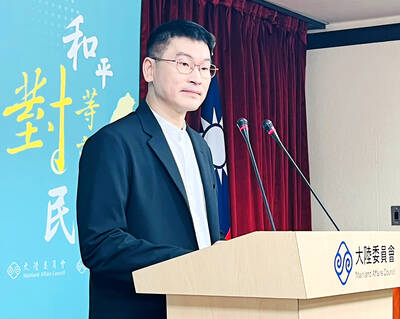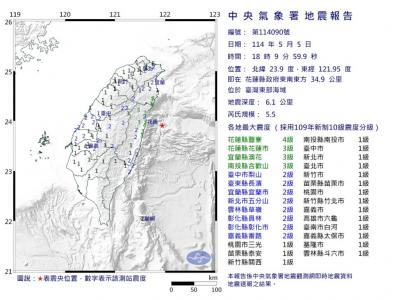President Tsai Ing-wen’s (蔡英文) inaugural address emphasized regional and cross-strait stability, active participation in international trade deals and deepening relationships with democracies such as the US, Japan and European nations, academics said, adding that Tsai was sending a message to Washington and Tokyo, calling on them to take Taiwan more seriously.
Taiwan Association of University Professors secretary-general Hsu Wen-tang (許文堂) — commenting on Tsai not affirming the so-called “1992 consensus” — said there were indeed talks between then-chairman of the Straits Exchange Foundation Koo Chen-fu (辜振甫) and then-chairman of China’s Association for Relations Across the Taiwan Straits Wang Daohan (汪道涵), and that is why Tsai said the cross-strait interaction of the time is a “historical fact.”
However, the term “1992 consensus,” coined by former Mainland Affairs Council chairman Su Chi (蘇起) for then-president Ma Ying-jeou’s (馬英九) use, is fake, and mostly not accepted by Taiwanese, Hsu said.
“Tsai’s phrasing of the cross-strait relationship [in the speech] was intended to not allow China room to make a fuss,” Hsu said.
The “1992 consensus” refers to a tacit understanding between the Chinese Nationalist Party (KMT) and the Chinese government that both sides of the Strait acknowledge there is “one China,” with each side having its own interpretation of what “China” means.
Hsu said Tsai’s message that she intended to further develop relationships with the US, Japan and European countries and cooperate with them based on common values was a call to the international community and democracies around the world to see Taiwan as a crucial partner.
Tsai stressed the Republic of China’s constitutional order as a message to China that there is no room to bargain over sovereignty, Hsu said, adding that Tsai is also expected to bolster cooperation with the US in the South China Sea and uphold freedom of navigation in those waters.
Chen Mu-min (陳牧民), chairman of the Graduate Institute of International Politics at National Chung Hsing University, said the highlight of the diplomatic policies in Tsai’s speech was the importance placed on Taiwan’s connections with the international community.
While former president Chen Shui-bian (陳水扁) emphasized “Taiwanese consciousness” and Ma focused on cross-strait peace, the new government has shown that it plans to improve ties in the region by participating in Asia-Pacific activities and building an economic community to scale the nation’s economy upward, Chen Mu-min said.
Tsai highlighted that Taiwan would be a staunch guardian of regional peace while deepening its relationship with the US and Japan based on the universal values of peace, democracy, liberty and human rights, Chen Mu-min said.
“She also asserted that Taiwan would not be a troublemaker in the South and East China seas,” he said.

An essay competition jointly organized by a local writing society and a publisher affiliated with the Chinese Communist Party (CCP) might have contravened the Act Governing Relations Between the People of the Taiwan Area and the Mainland Area (臺灣地區與大陸地區人民關係條例), the Mainland Affairs Council (MAC) said on Thursday. “In this case, the partner organization is clearly an agency under the CCP’s Fujian Provincial Committee,” MAC Deputy Minister and spokesperson Liang Wen-chieh (梁文傑) said at a news briefing in Taipei. “It also involves bringing Taiwanese students to China with all-expenses-paid arrangements to attend award ceremonies and camps,” Liang said. Those two “characteristics” are typically sufficient

A magnitude 5.9 earthquake that struck about 33km off the coast of Hualien City was the "main shock" in a series of quakes in the area, with aftershocks expected over the next three days, the Central Weather Administration (CWA) said yesterday. Prior to the magnitude 5.9 quake shaking most of Taiwan at 6:53pm yesterday, six other earthquakes stronger than a magnitude of 4, starting with a magnitude 5.5 quake at 6:09pm, occurred in the area. CWA Seismological Center Director Wu Chien-fu (吳健富) confirmed that the quakes were all part of the same series and that the magnitude 5.5 temblor was

The brilliant blue waters, thick foliage and bucolic atmosphere on this seemingly idyllic archipelago deep in the Pacific Ocean belie the key role it now plays in a titanic geopolitical struggle. Palau is again on the front line as China, and the US and its allies prepare their forces in an intensifying contest for control over the Asia-Pacific region. The democratic nation of just 17,000 people hosts US-controlled airstrips and soon-to-be-completed radar installations that the US military describes as “critical” to monitoring vast swathes of water and airspace. It is also a key piece of the second island chain, a string of

The Central Weather Administration has issued a heat alert for southeastern Taiwan, warning of temperatures as high as 36°C today, while alerting some coastal areas of strong winds later in the day. Kaohsiung’s Neimen District (內門) and Pingtung County’s Neipu Township (內埔) are under an orange heat alert, which warns of temperatures as high as 36°C for three consecutive days, the CWA said, citing southwest winds. The heat would also extend to Tainan’s Nansi (楠西) and Yujing (玉井) districts, as well as Pingtung’s Gaoshu (高樹), Yanpu (鹽埔) and Majia (瑪家) townships, it said, forecasting highs of up to 36°C in those areas